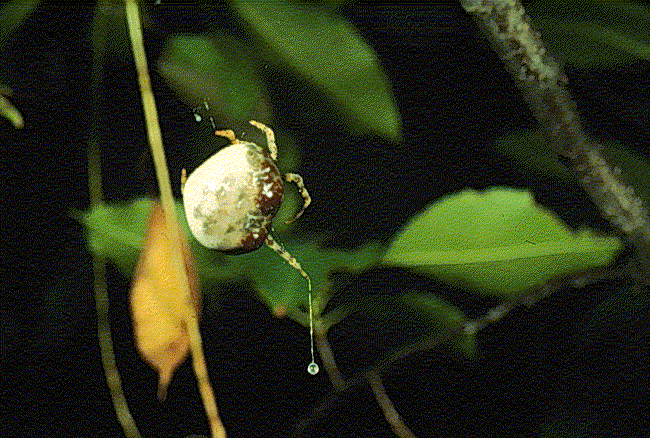Aggressive Chemical Mimicry of Prey Pheromones

Mastophora hutchinsoni, a bolas spider
Evolutionary specialization of a predator on a few prey species has potential
advantages and disadvantages. Such a predator can evolve to become highly efficient at
finding, handling, and utilizing its prey, but the predator becomes dependent on
availability of these particular prey, which could be costly in years of prey scarcity.
The bolas spider Mastophora hutchinsoni is an extremely specialized predator. The
adult female emits chemical attractants that mimic the sex pheromones of its moth prey, a
form of aggressive chemical mimicry. The spider exploits the inherent mate-finding
behavior of its victims, which are male moths. Two moth species, one active early at night
and the other late at night, account for more than 90% of this predator's prey; only two
other moth species are ever captured. When prey approach the spider, it strikes them with
a sticky ball at the end of a short thread. This capture device, called a bolas,
represents a highly reduced web that the spider swings with one of its forelegs. To
attract mates, female moths of the two principal prey species release blends of chemical
compounds that do not overlap in their components. The spider could produce a master blend
of all these components, but preliminary results indicate this would make the attractant
much less efficient in luring one of the spider's two principal prey species. If the
spider could adjust its attractant blend to predictable and unpredictable variation in
prey abundance, it would be a much more efficient predator and could minimize a major
disadvantage of prey specialization. In this research, we propose to use a combination of
chemical, electrophysiological, and behavioral approaches to determine if this bolas
spider shows flexibility in its behavior or mimetic signal to improve its hunting
effectiveness. Specific questions to be addressed include the following: (1) Does the
spider's emitted signal change over the course of a night to correspond with the
predictably different diel patterns of sexual activity of its principal prey species? (2)
Does the emitted signal vary seasonally to correspond with predictable changes in
abundance of its prey species? (3) Do hunting tactics and the emitted signal vary
plastically with unpredictable prey availability? Studies of this system will lead to an
understanding of tradeoffs involved in the evolution of exploitation of chemical
communication and the role of behavioral plasticity in minimizing the costs of
specialization.
This work involves a collaboration with Dr.
Kenneth F. Haynes (Entomology, University of Kentucky).
[Return]

